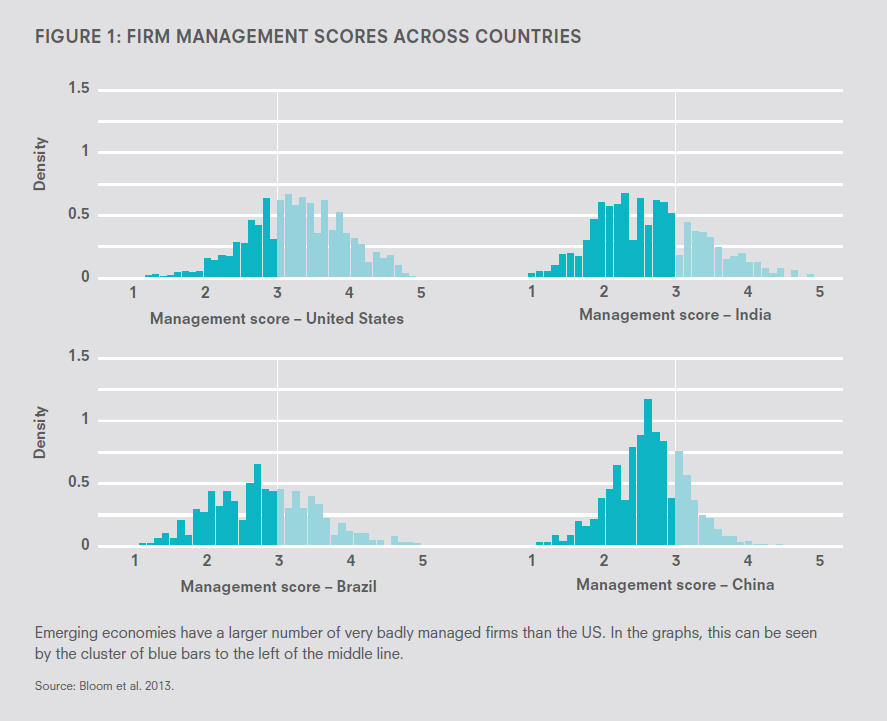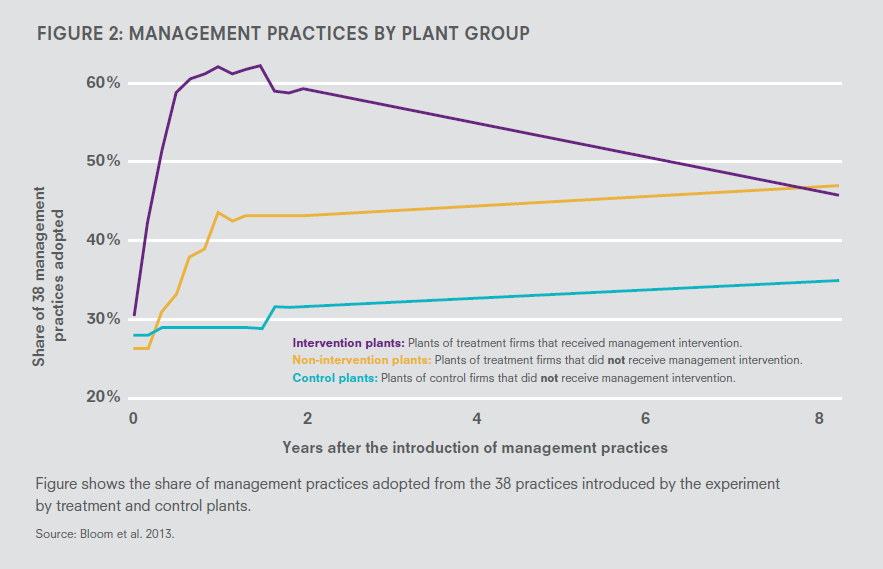
Management delivers: Why firms should invest in better business practices
There is a stark difference in firm productivity and growth between developing and advanced economies. Improving the management of firms in developing countries can help bridge this gap.
-
IGCJ6045_Management-Growth-Brief_180327_WEB.pdf
PDF document • 421.7 KB
Introduction
New research shows that introducing management practices to firms can have lasting impacts on their productivity and growth. When Indian firms adopted management practices, their productivity increased by 17% in the first year, and within three years, they opened more production plants. Eight years later, the impact of management on productivity persists.
This brief, which focuses on large private firms, examines why management matters for economic growth – demonstrating the long-term effects of management practices on firm productivity, and recommending actions for policymakers and firms to secure these benefits.
For economies to achieve sustained growth in incomes and large-scale reductions in poverty, firms must be productive and dynamic enough to generate income and jobs. However, many firms in developing countries are poorly managed, impeding their productivity and growth. Scoring of management practices in manufacturing firms reveals that management is significantly worse in developing countries than in developed countries. The average management score for Indian firms, for example, is 23% lower than the score for US firms.
Although management can be complex to measure, recent research has focused on specific management practices standard in American, European, and Japanese firms in the areas of factory operations, quality control, inventory, human resources, and sales and orders. An IGC randomised controlled trial (Bloom et al., 2013) of large Indian textile firms found that the adoption of a set of management practices, introduced to them with the support of a consulting firm, raised productivity by 17% and led these firms to open more production plants. Follow-up research shows that these effects have persisted.
This brief, which focuses on large private firms, examines why management matters for economic growth – demonstrating the long-term effects of management practices on firm productivity, and recommending actions for policymakers and firms to secure these benefits.
Key Messages
- Management practices have lasting positive effects on firm performance and growth.
After adopting management practices, Indian firms increased their productivity by 17% and opened more production plants. The impact of these management practices on firm productivity persists eight years later. - Management practices spread within and across large firms. These spillovers improve management in the long-run.
Within a firm, management improvements in plants that adopted management practices spilled over to plants that did not. These spillovers are the most important drivers of management improvements in the long-run. - Key employees such as plant managers and firm directors play a vital role in driving management practices.
Manager turnover is the biggest reason for a plant dropping management practices. The time that senior executives spend managing their plants also matters, with some management practices being dropped when they had to reduce their time managing.
Key message 1 – Management practices have lasting positive effects on firm performance and growth.
Economists have long documented large differences in firm performance across and within countries, and even within the same sector. For example, India’s total factor productivity – a measure of how efficiently inputs such as labour and capital are used – is approximately 40% of that of the US (Caselli, 2011).
Additionally, firms in low- and middle-income countries have, on average, much worse management practices than firms in high-income countries. This appears to be due to a large number of very badly managed firms and big differences in management scores across firms. Figure 1 below illustrates this, showing results from a large survey of manufacturing firms that scores management practices.
The drivers of firm growth are complex, but recent evidence has shown management practices affect productivity (Bloom et al., 2013; Bruhn et al., 2013). These studies found that companies with higher management scores are significantly more productive, profitable, and grow faster. Well-managed firms
are also larger, survive longer, employ more skilled workers, and are more likely to export.
Figure 1: Firm management scores across countries

The experiment
In an IGC-funded study targeting large Indian textile firms in 2008, 17 firms were randomly selected and divided into two groups:
- In one group, one plant in each firm received support from a consulting firm to implement business practices to improve management –based on basic manufacturing principles standard in high-income countries, such as regularly maintaining machines, addressing quality defects, organising inventory, and managing sales and orders.
- In the other group, firms did not receive any support to implement business practices.
The findings
Those in the first group (treatment group) saw an increase in output of 9% and a rise in productivity of 17% compared to the second group (control group). These performance boosts were driven by higher quality and reduced inventory, corresponding to an average increase of about $325,000 in profits per year per plant. Moreover, this average profit increase in a single year exceeded the cost of the consulting services used, making it a cost-effective investment for firms.
The practices also affected firm growth. Following the intervention, firms that received consultancy support operated a significantly larger number of plants compared to both firms in the control group and in the rest of the industry. This was due to improved management practices enabling firm directors to delegate more responsibilities to their plant managers, while still being able to monitor progress closely based on the additional data and channels available to them.
Long-term impacts
Eight years after the initial intervention, researchers revisited the Indian firms and found that the impact on management practices and firm performance persisted:
- While about half of the introduced practices had been dropped, firms that had received the consultancy support continued to perform significantly better than those that had not.
- Out of the 38 practices introduced to the firms in the original intervention, 14 practices, once adopted, were not dropped by a single plant eight years later. These practices enabled directors to delegate more responsibilities to managers, as seen in the short-term results.
- The practices that persisted for most plants related to the most immediate improvements in quality and inventory – including recording quality defects systematically, having a system for monitoring and disposing of old stock, and carrying out preventative maintenance of machines.
- The intervention had a positive long-term impact on firm performance. The follow-up study supplemented previously collected data with data on plant size and the number of textile looms. These revealed that treatment firms saw average long-run increases of 34% in production (as measured by the number of looms) and 9% in productivity (looms per employee) in their plants as compared to firms in the control group.
These lasting effects underline the importance of management practices in explaining systematic differences in performance between firms.

Woman working in textile factory. Photo: Getty | Noah Seelam.
Key message 2 – Management practices spread within and across large firms. These spillovers improve management in the long-run.
Evidence shows that policy interventions, rather than small ones, can be cost-effective and have large benefits. In large firms, practices introduced in one part of a firm are likely to spread internally and benefit other parts of the firm – this spreading of practices is important for ensuring that management improvements last. Eight years after the original Bloom et al. (2013) experiment on Indian textile firms ended, researchers found that management practice improvements in plants that received the intervention spilled over to plants that did not.
Figure 2 shows how management practices changed over time in plants within the same firm. The treatment plants adopted a multitude of management practices during the original experiment in 2008–2010, and therefore had substantially higher management scores by 2011. Their scores then declined as they dropped practices.
Other plants within the same firms that did not receive the intervention adopted fewer of these management practices in 2008–2010 but continued to adopt practices so that their management scores eventually caught up to the intervention plants in 2017.
Spillovers from other plants within the same treatment firm were the most important driver of management improvements over the eight years after the experiment, contributing to more than one-third of the total improvement rate. As seen in Figure 2, despite treatment firms dropping some practices, their overall management score is still higher than that of control firms eight years later.
Given the important role of spillovers in improving management over the long run, more research is needed to examine in detail how and why this occurs across firms.
Figure 2: Management practices by plant group

Management practices in small firms
A number of IGC projects have examined the impact of management practices on micro, small, and medium-sized enterprises (MSMEs). A key difference is that MSMEs may be structured simply enough to work without formal systems for monitoring and evaluation as their owners can directly observe the full production process (McKenzie and Woodruff, 2012).
While traditional training programmes for entrepreneurs seem to not have the desired effects on business practices and productivity, more individualistic and diffuse approaches, such as mentoring programmes and horizontal (peer-to-peer) communication, are more promising (McKenzie and Woodruff, 2013).
Looking at the long-term effects of changes to management practices in MSMEs, the evidence is ambiguous. For example, an experimental study in Ghana shows that over time, firms largely reverted to their prior business practices (Karlan et al., 2015). On the other hand, a study in Mexico provides evidence that firms that received management consulting support increased their scale of business during a five-year period after the intervention, with a 57% increase in the number of employees (Bruhn et al., 2010).

Textile factory in India. Photo: Christophe Boisvieux | Getty.
Key message 3 – Key employees such as plant managers and firm directors play a vital role in driving management practices.
The long-term results from Bloom et al. (2017) show that plant managers and firm directors play a critical role in improving management. In plants that received the original management intervention, manager turnover is the biggest reason for a plant dropping management practices.
Time spent managing by senior executives is another major factor – 3.6% of management practices were dropped when directors such as Chief Executive Officers (CEOs) and Chief Finance Officers (CFOs) spent less time managing the plant (as compared to when the original intervention took place), often because they were pulled into other business areas such as finance, marketing, and retail. Similarly, a study of over 1,000 CEOs in six of the world’s ten largest economies supports the finding that how CEOs spend their time affects firm performance (Bandiera et al., 2017).
Another study involving a large American service company with close to 24,000 workers and 2,000 supervisors shows that good managers significantly affect worker productivity. A very good supervisor – as measured by their effect on worker productivity – increases the output of their managed team over the output of a team managed by a very bad supervisor by about as much as having one additional member on the team (Lazear et al., 2015).
Conviction in a business practice’s benefits also plays a role in management practices sticking – 4.2% of practices from the original Bloom et al. (2013) intervention were dropped because firms decided the practices were not worth adopting.
Relatedly, more common practices, such as basic measurement systems, were more likely to be maintained. Uncommon practices, such as signs displaying plant procedures that very few firms were using before the intervention, were most likely to be dropped after the intervention ended. Here, training to explain and demonstrate the benefits of new practices could play a crucial role.
Measuring management practices in developing countries
Several IGC projects have examined the quality of management in firms in Asia and Africa by scoring basic management practices across industries and sectors, based on a Management and Organisational Practices Survey (MOPS) that builds on the work
of Bloom and Van Reenen (2007). The original survey was sent to about 50,000 US manufacturing plants in 2011 and 2016 through the US Census Bureau, the largest survey of management practices to date.
India: IGC research analysing the manufacturing, retail, healthcare, and education sectors found that India’s management practices were, on average, poorer than in Europe and North America. In the US, only 2% of firms have little or no modern management practices implemented – in India, it is 25% of firms (Lemos and Scur, 2012).
Pakistan: Examining almost 2,000 firms, researchers found Pakistani plants have lower average management scores than American plants and scores are more dispersed, suggesting that poorly managed firms close down more slowly in Pakistan. Data also suggest that a 10% increase in the management score is associated with a 12% increase in labour productivity, which is very similar to the US (Bloom et al., 2016).
Mozambique: Using data from Mozambique and 32 other developed and developing countries, IGC research finds Mozambique at the bottom of the global rank of management practices, along with other African countries. Although some firms in Mozambique have high quality management practices, there is a substantial number of badly-managed firms, dragging down the country’s average management score. In fact, 89% of Mozambican firms score within the range of the bottom 25% of US firms (Lemos and Scur, 2014).
Policy recommendations
Research has shown that effective management practices can have long-term benefits for firm productivity and growth and employment, which are key drivers of economic growth in developing countries. However, more evidence is needed to understand why firms do not invest in improving management and what policies could change this. Both the private sector and policymakers can take steps to support the role of management in improving firm performance.
- Firms should invest in management practices and governments should consider supporting this. It is cost-effective for firms to invest in management practices; evidence shows that firms can recover the consulting costs within a year and see persisting benefits. Governments should consider measures to incentivise firms to enhance management practices given the large, long-term spillover effects of the adopted practices. Options include using quality consultancy interventions (as in Bloom et al, 2013) or training that demonstrates the benefits to firms of adopting management practices.
- Governments and firms should invest in human capital. Firms with better-educated managers tend to be better managed. Basic operations and high-impact skills training programmes are efficient and cost-effective options.
- Firms should promote information sharing. Making managers aware of best practices and helping them evaluate their own approach can be beneficial. This can be achieved through regular management meetings across firms (Cai et al., 2016) or easy-to-read, hands-on publications.
- Firms should retain effective managers. Supporting professional development and incentives to retain key staff and implementing meaningful handover processes for new managers helps to ensure that effective practices persist.
- Governments should encourage competition. Manufacturing plants that face higher competition tend to be better managed as they may otherwise be forced out of the market. This suggests that economic policies supporting greater competition can drive increases in productivity through better management practices.

Supervisor in Indian factory. Photo: Chandhan Khanna | Getty.
References
Bandiera, O., Hansen, S., Prat, A., and Sadun, R. (2017). “CEO Behavior and Firm Performance”. The National Bureau of Economic Research, Working Paper No. 23248.
Bloom, N., Eifert, B., Mahajan, A., McKenzie, D., and Roberts, J. (2013). “Does Management Matter? Evidence from India”. The Quarterly Journal of Economics, Volume 128, Issue 1.
Bloom, N., Mahajan, A., McKenzie, D., and Roberts, J. (2017). “Do Management Interventions Last? Evidence from India”. The Centre for Economic Policy Research (CEPR).
Bloom, N. and Van Reenen, J. (2007). “Measuring and Explaining Management Practices Across Firms and Countries”. The Quarterly Journal of Economics, Vol. CXXII November 2007 Issue 4.
Bruhn, M., Karlan, D., and Schoar, A. (2010). “What Capital is Missing in Developing Countries?”. American Economic Review: Papers & Proceedings 100: 629–633.
Bruhn, M., Karlan, D., and Schoar, A. (2013). The Impact of Consulting Services on Small and Medium Enterprises Evidence from a Randomized Trial in Mexico. The World Bank, Development Research Group, Finance and Private Sector Development Team, Policy Research Working
Paper 6508.
Cai, J. and Szeidl, A. (2016). “Interfirm Relationships and Business Performance”. CEPR Discussion Paper No. 11717.
Karlan, D., Knight, R., and Udry, C. (2015). “Consulting and Capital Experiments with Microenterprise Tailors in Ghana”. Economic Journal of Economic Behavior & Organization, Volume 118, October 2015, Pages 281–302, Journal of Economic Behavior & Organization.
Lazear, E., Shaw, K., and Stanton, C. (2015). “The Value of Bosses”. Journal of Labor Economics, Volume 33, Number 4.
Lemos, R. and Scur, D. (2012). Could Poor Management be Holding Back Development? Describing Practices in the Public and Private Sectors in India. International Growth Centre Working Paper No. F-6006-INC-1.
Lemos, R. and Scur, D. (2014). Management Practices in Manufacturing in Mozambique. International Growth Centre Working Paper No. F-36108-MOZ-1.
McKenzie, D. and Woodruff, C. (2012). What Are We Learning from Business Training and Entrepreneurship Evaluations around the Developing World? Discussion Paper No. 6895, Forschungsinstitut zur Zukunft der Arbeit Institute for the Study of Labor.
McKenzie, D. and Woodruff, C. (2013). What Are We Learning from Business Training and Entrepreneurship Evaluations around the Developing World? Oxford University Press on behalf of the International Bank for Reconstruction and Development and the World Bank Research Observer.



